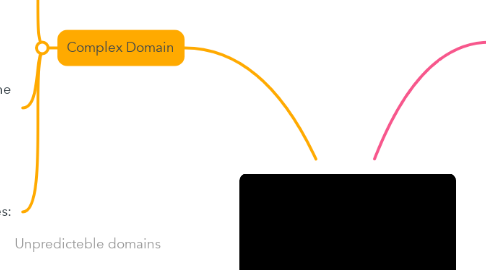
1. Chaos Domain
1.1. In the chaotic domain, no cause and effect relationship can be determined. We have to stabilise the position very quickly!
1.2. We discover **novel practice** and the approach is to: **Act → Sense → Respond**
1.2.1. Act: Attempt to stabilise
1.2.2. Sense: Failures or successes
1.2.3. Respond: Decide what to do next
1.3. Examples:
1.3.1. A medical emergency situation.
2. Unpredicteble domains
3. Complex Domain
3.1. In the complex domain, we have unorder where the relationship between cause and effect can only be perceived in retrospect and the results are unpredictable. Complex systems are therefore dispositional and not causal. Here, we need to create safe to fail experiments and not attempt to create fail safe design. We cannot solve complex problems with best or good practices alone. While conducting safe to fail experiments, we must dampen the parts that fail and amplify the parts that succeed. In this domain we get emergent order and practice that is often unique.
3.2. **Emergent (Agile) practice,** and the approach is to: **Probe → Sense → Respond**
3.2.1. Probe: Experimental input
3.2.2. Sense: Failures or successes
3.2.3. Respond: Decide what to do i.e. amplify or dampen
3.3. Examples:
3.3.1. Most types of innovation. Professional training or best practices are replaced with probing different approaches and ideas, sensing the results/feedback to see what works and what doesn’t, and responding appropriately (by amplifying and dampening our probes).
4. Obvious/Simple Domain
4.1. In the obvious/simple domain, we are in an ordered system where the relationship between cause and effect exists, is predictable in advance and is self evident or obvious to any reasonable person.
4.2. **Best practices**, and the approach is to: **Sense → Categorise → Respond**
4.2.1. Sense: See what’s coming in
4.2.2. Categorise: Make it fit predetermined categories
4.2.3. Respond: Decide what to do
4.3. Examples:
4.3.1. A clerk in a banking institution calculating compound interest. Best practise is applied in terms of predefined formulae and given an input the results are always the same.
4.3.2. Coding guidelines in software development => apply the standard
5. Predictable domains
6. Complicated Domain
6.1. In the complicated domain, we have an ordered system where there is a right answer and where a relationship does exist between cause and effect, however, the answer is not self-evident and requires analysis and/or the application of expert knowledge. With the right expertise, there can be several different ways of doing things in this domain.
6.2. **Good practices**, and the approach is to: **Sense → Analyse → Respond**
6.2.1. Sense: See what’s coming in
6.2.2. Analyse: Investigate or analyse, using expert knowledge
6.2.3. Respond: Decide what to do
6.3. Examples:
6.3.1. Designing and building a mechanical watch
6.3.2. Anything that can be solved with professional training or external consulting services, like the need to develop software in a specific language (ie. C# or Java).
